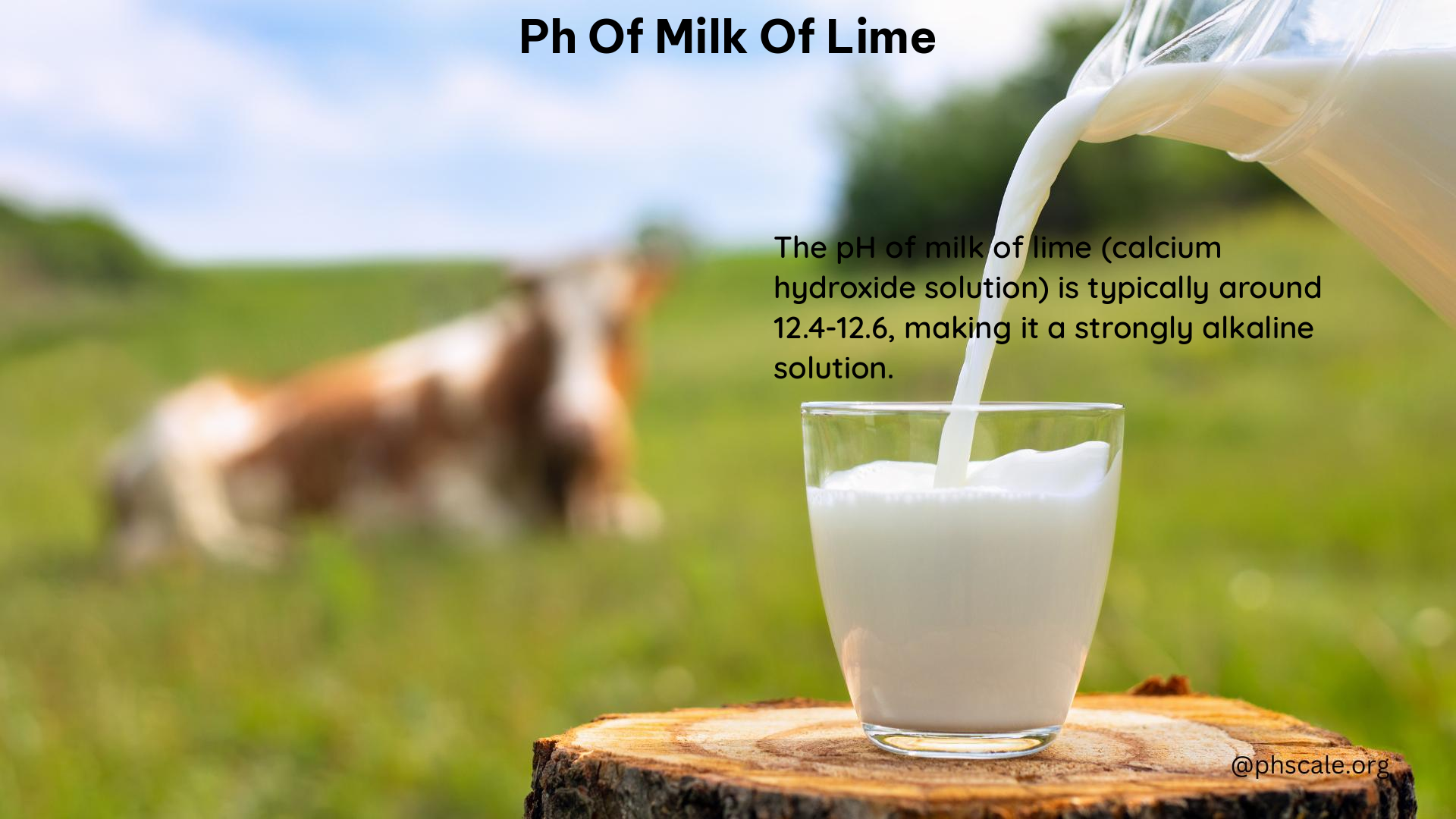The pH of milk of lime is typically around 12.45, making it a highly alkaline substance. This is significantly higher than the pH of water, which is neutral at 7. The high pH of milk of lime is due to its composition as a calcium hydroxide slurry, a strong base. This unique property makes milk of lime useful for various industrial applications, such as water treatment and neutralizing acidic substances.
Understanding the Composition of Milk of Lime
Milk of lime, also known as limewater, is a suspension of calcium hydroxide (Ca(OH)2) in water. It is produced by slaking, or hydrating, quicklime (calcium oxide, CaO) with water. The chemical reaction that takes place is as follows:
CaO + H2O → Ca(OH)2
The resulting calcium hydroxide is a white, powdery substance that is only slightly soluble in water, forming a milky-white suspension known as milk of lime.
Measuring the pH of Milk of Lime

The pH of milk of lime is typically measured using a pH meter or pH test strips. The high pH of around 12.45 is due to the presence of the hydroxide ions (OH-) in the calcium hydroxide solution. These hydroxide ions are responsible for the alkaline nature of milk of lime.
To determine the pH of a sample of milk of lime, follow these steps:
- Collect a small sample of the milk of lime.
- Dilute the sample with distilled water, if necessary, to ensure accurate pH measurement.
- Insert the pH meter or dip the pH test strip into the diluted sample.
- Wait for the reading to stabilize and record the pH value.
It’s important to note that the exact pH of milk of lime may vary slightly depending on the concentration of the calcium hydroxide solution and the presence of any impurities.
Industrial Applications of Milk of Lime
The high pH of milk of lime makes it a valuable substance in various industrial applications. Some of the common uses of milk of lime include:
-
Water Treatment: Milk of lime is used in water treatment processes to adjust the pH of water, remove impurities, and soften hard water. The alkaline nature of milk of lime helps to neutralize acidic substances and precipitate out heavy metals and other contaminants.
-
Neutralization of Acidic Substances: Milk of lime is used to neutralize acidic substances, such as those found in industrial waste streams or mining operations. The high pH of milk of lime helps to raise the pH of the acidic solution, making it less harmful and easier to dispose of or treat further.
-
Paper and Pulp Industry: Milk of lime is used in the paper and pulp industry to adjust the pH of the pulp during the papermaking process. This helps to optimize the chemical reactions and improve the quality of the final product.
-
Agriculture: Milk of lime is used as a soil amendment in agriculture to increase the pH of acidic soils, making them more suitable for plant growth.
-
Construction: Milk of lime is a key ingredient in the production of mortar, plaster, and other construction materials, where its high pH helps to bind the materials together and provide strength and durability.
-
Chemical Industry: Milk of lime is used in the production of various chemicals, such as calcium carbonate, calcium chloride, and calcium hypochlorite, which have a wide range of industrial applications.
Handling and Storage of Milk of Lime
Due to the high pH of milk of lime, it is important to handle and store it properly to ensure safety and prevent any potential hazards. Here are some guidelines for handling and storing milk of lime:
-
Personal Protective Equipment (PPE): When handling milk of lime, it is essential to wear appropriate PPE, such as gloves, goggles, and a face mask, to protect against skin and eye irritation.
-
Storage Conditions: Milk of lime should be stored in a cool, dry, and well-ventilated area, away from direct sunlight and heat sources. The storage containers should be made of corrosion-resistant materials, such as plastic or stainless steel.
-
Shelf Life: Milk of lime has a relatively short shelf life, typically around 6-12 months. It is important to use the product within this timeframe to ensure its effectiveness and safety.
-
Disposal: Any unused or expired milk of lime should be disposed of in accordance with local environmental regulations. It should not be poured down drains or into water bodies, as the high pH can be harmful to aquatic life.
Conclusion
The pH of milk of lime, typically around 12.45, is significantly higher than the neutral pH of water. This high alkalinity is due to the presence of calcium hydroxide, a strong base, in the milk of lime suspension. The unique properties of milk of lime make it a valuable substance in various industrial applications, such as water treatment, neutralization of acidic substances, and the production of construction materials. However, it is important to handle and store milk of lime with care to ensure safety and prevent any potential hazards.
Reference:
– Milk of Lime: Properties, Production, and Applications
– Calcium Hydroxide: A Review of Its Chemistry, Environmental Applications and Opportunities
– The Use of Lime in Water and Wastewater Treatment
